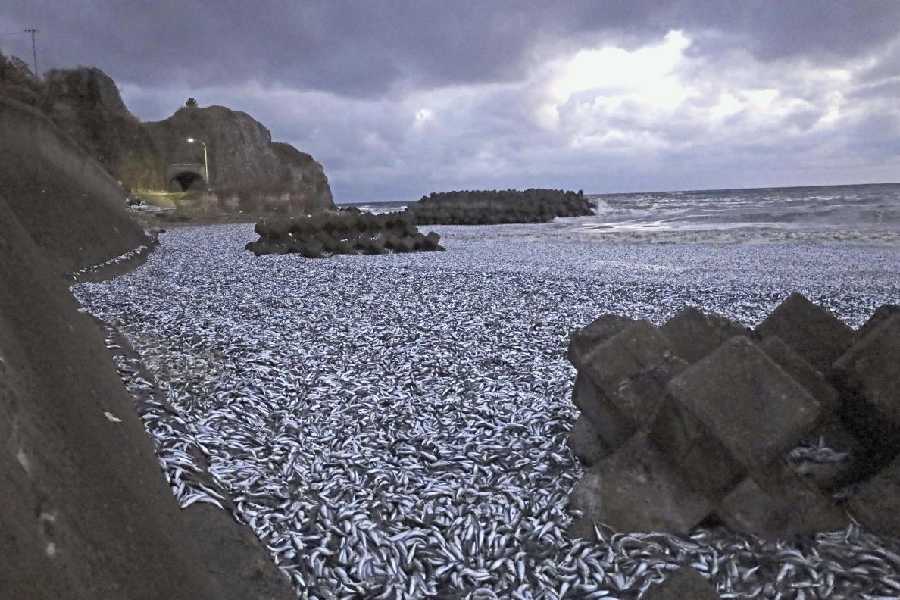Preface
Deep-Sea creatures are appearing on land in rising numbers, puzzling scientists. Reports in 2025 of giant squid and glowing species raise concern.

What Is Happening?
Over the past few months, coastal regions have witnessed an unusual surge in deep-sea creatures washing up on beaches or appearing in shallow waters. Some of these species, typically found thousands of meters beneath the ocean surface, have never been seen alive by human eyes. Reports include: –
- Giant squid appearing on the shores of Japan and New Zealand
- Anglerfish and vampire squid found in shallow waters near California and Australia
- Fanged deep-sea fish like the gulper eel and dragonfish spotted along coastlines
- Bioluminescent jellyfish lighting up beaches in Florida and Indonesia at night
- Approx. 7 Lakhs Olive Ridley Turtles arrives at the coast in Odisha, India
- Thousands of Fish washed ashore on a beach in Kerala, India.
(Watch the Video on YouTube: Thousands of Fishes Emerging on Land in Kerala)
The frequency and diversity of these appearances suggest a significant shift in marine ecosystems.

Possible Causes Behind This Phenomenon
- Climate Change and Ocean Warming
The increasing temperature of the oceans is one of the leading theories behind this event. Rising sea temperatures force deep-sea creatures to move into shallower, cooler waters in search of their preferred conditions. As their habitats become unsuitable, these creatures may be unintentionally venturing toward the surface and even onto shores.
2. Deep-Sea Volcanic Activity
Recent seismic activity in the Pacific and Atlantic Oceans suggests that underwater volcanic eruptions may be disrupting marine ecosystems. These eruptions release gases and heat, drastically altering the environment of deep-sea species and potentially driving them upwards.
3. Underwater Mining and Human Interference
The growing interest in deep-sea mining for rare minerals has led to increased human activity in previously untouched regions of the ocean. The disturbance caused by large-scale mining operations could be displacing deep-sea species, forcing them to seek new environments.
4. Depleting Oxygen Levels in the Deep Ocean
Recent studies suggest that certain deep-sea regions are experiencing declining oxygen levels due to pollution and rising temperatures. As oxygen levels drop, creatures adapted to deep-sea conditions may be compelled to move towards the surface, where oxygen is more available.
5. Unknown Biological or Ecological Factors
Scientists have also theorized that unknown biological changes in deep-sea ecosystems, such as new predator-prey dynamics, viral outbreaks, or mutations, could be influencing this phenomenon. More research is needed to confirm these possibilities.
Impact on Coastal Ecosystems and Human Populations
The sudden appearance of deep-sea creatures on land has several consequences:
- Ecosystem Disruption: Many of these species do not belong in shallow waters and may disrupt local ecosystems by preying on native marine life.
- Potential Health Hazards: Some deep-sea creatures produce toxins or carry unknown bacteria that could pose health risks to humans and animals.
- Fisheries and Economy: Commercial fisheries are already reporting changes in fish populations, as deep-sea creatures compete with traditional fish species in new environments.
- Tourism and Public Curiosity: While some people are fascinated by these rare creatures, others fear what their appearance may signify for the planet’s oceans.
The Path Forward: How Scientists Are Responding
Marine biologists, oceanographers, and climate scientists are working together to study this phenomenon. Some of the ongoing research efforts include:
- Satellite and sonar mapping to track deep-sea movements
- Water quality assessments to determine changes in temperature, oxygen levels, and pollutants
- Genetic studies to analyze whether these creatures are experiencing mutations or adaptations
- Global collaborations to monitor oceanic changes and potential future patterns
Conclusion
The sudden emergence of deep-sea creatures onto land in 2025 is a mystery that highlights the delicate balance of our marine ecosystems. Whether driven by climate change, human interference, or unknown ecological factors, this event serves as a reminder of how interconnected our world truly is. As scientists continue their investigations, one thing remains clear—our actions on land and in the sea have profound consequences on life beneath the waves.
Understanding these changes is crucial not only for marine life but also for the future of humanity’s relationship with the ocean. The question now is: What will the ocean reveal next?
Also read:
Digital Blackout: UPI Crashed !!!
JioCoin: Shaping India’s Digital Future
Los Angeles 2025: A City in Flames
